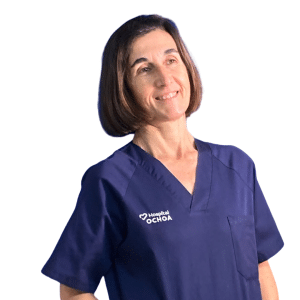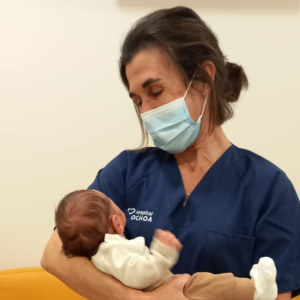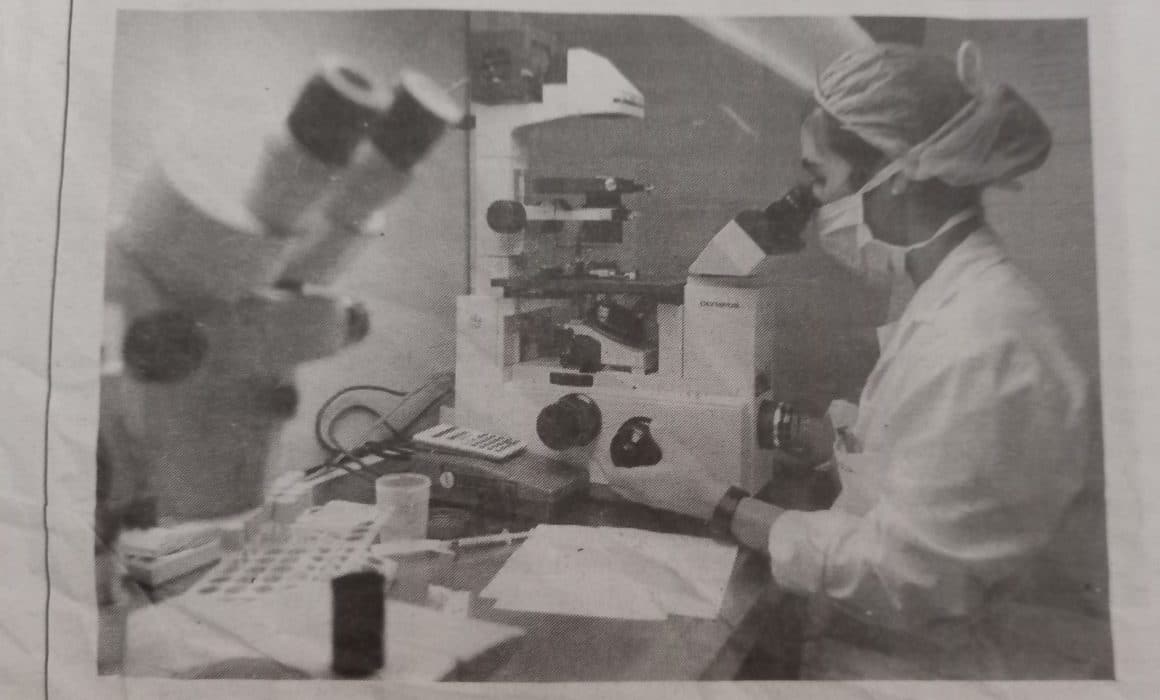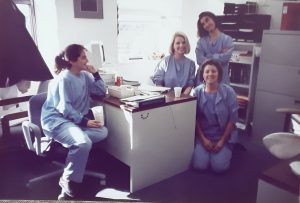The Evolution of Assisted Reproduction in Spain through the Experience of an Embryologist
Discover how assisted reproduction has evolved in Spain through the eyes of a prominent embryologist with 32 years of experience in the field. Join us on this exciting journey through history and the advancements that have transformed the science of fertility.
Today, I want to introduce you to Maria Jose Figueroa, a prominent embryologist with 32 years of experience in the field of assisted reproduction.
Her story is a true inspiration, and thanks to her incredible career, we will explore how the landscape of assisted reproduction has evolved over the years.

Maria Jose, originally from Jerez de la Frontera, is the eldest of six siblings, which undoubtedly instilled in her the importance of care and responsibility. After studying biology in Seville, she ventured into the exciting world of assisted reproduction.
In fact, it was thanks to a chance meeting with a colleague at an alumni event where Maria Jose learned about a gynecology clinic in Jerez that was looking for a biologist to assist in assisted reproduction techniques. Without hesitation, she applied for the opportunity.
Thus, in February 1992, she began her journey in assisted reproduction. At that time, there were no formal specialization programs in embryology, but she embarked on a learning journey alongside the best specialists of the time. Her first stop was Valencia, where she learned from Mª Jose de los Santos and Emilio Gómez. Later, she crossed the ocean with Carmen Calatayud (CREA). She visited the Jones Institute for Reproductive Medicine in Norfolk, United States.
In Norfolk, alongside Lucinda Veek, a pioneer in the field of assisted reproduction, Maria Jose immersed herself in an entirely new world. It was like being at NASA, witnessing the first ICSI tests, a revolutionary method in assisted reproduction. There, always working closely with Silvina Bocca, she learned techniques for reconstituting culture media, embryo classification and freezing, as well as Norfolk’s rigorous morphological criteria for sperm classification.
“When I arrived there… from Jerez to Norfolk, it was like being at NASA. I remember Lucinda Veek entering a room to perform the first ICSI tests. She had set up the basic microinjection system under a baby incubator.”
Norfolk, 1993
In 1995, she visited the University of Leeds to learn about ovarian tissue freezing. There, she met Roger Gosden, one of the pioneers in this field, from whom she learned the first technical concepts.
Furthermore, her commitment to science and love for nature led her to collaborate with the Jerez Zoo and the Doñana National Park on various conservation projects, including a project for the conservation of the Iberian lynx. Semen and ovarian tissue freezing techniques were put into practice.
“I loved going to Sanlúcar, crossing to Doñana in the barge, and being picked up in the Land Rover to reach the reserve… the lynxes had their own names.”
Maria Jose has witnessed a true journey through time within assisted reproduction. From its beginnings when techniques were performed in small gynecology clinics that constituted the first Assisted Reproduction Units, to the present day, where specialization and advanced technologies are fundamental to the process.
Today, Maria Jose works as an embryologist in Marbella, at the FIV OCHOA Assisted Reproduction Unit at the Ochoa Hospital. There, she continues her professional career with the same enthusiasm as the first day!
Beginnings of assisted reproduction in Spain.
In 1992, when she began working in assisted reproduction, there were about 30 assisted reproduction clinics in Spain. Her clinic was the only one in the entire province of Cadiz, Spain.
At that time, treatments were quite limited compared to the options available today. The most common procedures were inseminations, either with the partner’s or donor’s semen, and in vitro fertilization (IVF). Techniques such as ICSI (intracytoplasmic sperm injection) and embryo vitrification did not yet exist.
Freezing eggs was prohibited in Spain, and slow freezing yielded poor results. Egg donation was limited to cases where patients had surplus eggs from their own assisted reproduction cycle and decided to donate them fresh. Additionally, there were no quality controls or computer systems, and patient records were handwritten or typed on paper.
The patients who sought these clinics were mainly heterosexual, married couples, usually young, between 28 and 35 years old, who had been trying to conceive without success for several years.
Laboratories in the 90s: A different world
Assisted reproduction laboratories in the 90s were very different from modern and advanced laboratories today. Maria Jose recalls that her first laboratory was just a small room measuring 2.5m x 2.5m, equipped with the essentials to carry out procedures.
Microscopes were not yet part of the basic equipment, and Pasteur pipettes were washed, sterilized, and manually prepared by heating and stretching them over a flame.
“The first laminar flow cabinet that I had, which could be heated, I got because my friend Miguel Ruiz from CREA told me: Maria José, go to a pet store and buy warm plates they sell for reptiles, and stick them under the cabinet, that way it will reach 37 degrees.”
Laboratories at the time did not use oil on culture plates, and due to their size, incubators housed biological material from all patients, requiring constant openings and closures that made it difficult to maintain optimal culture conditions. Each day posed a challenge to maintain the appropriate conditions within the incubator.
At that time, it was common for clinics to have an animal facility to practice techniques and test culture media. Maria Jose had one thanks to her collaboration with the Jerez Zoo.
Improvements in facilities and protocols have significantly contributed to increasing the efficiency and safety of assisted reproduction treatments.
Landmark changes in assisted reproduction
For Maria Jose, the major milestones in assisted reproduction could be summarized as follows:
- The creation of ASEBIR (The Spanish Association for the Study of Reproductive Biology) in 1993. It was fundamental in Spain as it encouraged all biologists in the sector to share their data and established morphological criteria for everyone to speak the same language.
- Obtaining sperm through testicular biopsy, which was implemented in her clinic shortly after the introduction of ICSI. It opened up new possibilities for males diagnosed with azoospermia.
“We appeared on TV and everything because we achieved the first pregnancy in Andalusia using frozen semen from a testicular biopsy.”
- The arrival of ICSI around 1994. This revolutionary fertilization technique allowed many couples who could not achieve pregnancy with traditional IVF to conceive successfully.
“The learning curve was with the patients’ own eggs, on the waiting list for the technique.”
- The introduction of vitrification, an ultra-rapid freezing technique. It marked a milestone in the preservation of embryos and later eggs from 2009, increasing success rates and providing new opportunities for patients with difficulties conceiving.
“To freeze eggs, we had to request permission from the Health Department. All clinics requested our permits.”
- The development of culture media and the evolution of incubators have also greatly contributed to improving the results of assisted reproduction treatments.
“Incubators have gone from the size of a refrigerator to that of a compartmentalized sandwich maker. Now each patient is independent, so the manipulation of one does not affect the culture conditions of another, and the incubator quickly restores its conditions.”
- In the field of genetics, assisted reproduction has taken a giant leap. Currently, it is unthinkable to conceive an assisted reproduction laboratory without the integration of genetic techniques, such as PGD (preimplantation genetic diagnosis), which allows analyzing and selecting healthy embryos before transferring them to the mother’s uterus.
The Future of Assisted Reproduction: automation and artificial intelligence as allies
Finally, the emergence of automation in laboratories and the advancement of artificial intelligence are some of the main trends that will shape the future of assisted reproduction in the coming years. According to María José, it will greatly facilitate the work but will not replace embryologists. There will always need to be embryologists to oversee and review things.
In conclusion, the evolution of assisted reproduction in Spain has been astonishing. Maria Jose’s story is a living testament to how passion, dedication, and determination can transform an emerging science into cutting-edge practice that changes many people’s lives.



